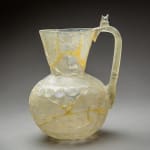Islamic Glass Pitcher, 7th Century CE - 9th Century CE
Hot-worked Glass
15.5 x 11.4 cm
6 1/8 x 4 1/2 in
6 1/8 x 4 1/2 in
LO.913
Further images
Although the development from the pre-Islamic period to the middle of the ninth century is very recognizable in architecture, including works in stone, plaster and wood, it becomes quite blurred...
Although the development from the pre-Islamic period to the middle of the ninth century is very recognizable in architecture, including works in stone, plaster and wood, it becomes quite blurred on other media such as metalwork and pottery. Between the 5th and the 8th century glass production seems unchanged, although the surviving objects would still point to an industry that persisted and thrived, almost careless of the political and religious turmoils of the Ummayad era, including the death of the prophet Muhammad. Perhaps, the diffusion of glass-blowing and the consequent paucity of high quality glass after the crumbling of the Roman Empire might have hampered the rulers' sponsorship of glassmaking, yet during this period glass became more accessible for mundane use and thus, by loosing its status value, less attractive to affluent patrons.
This almost globular pitcher of translucent greyish colourless glass, a shape often encountered in the Islamic world, has a large tall and flared neck, a L-shaped handle attached at the opening of the shoulder and a double pointed thumb rest at the top. On the slightly depressed globular body, the decoration consists of two rows of 20 circular facets which were scooped away at even close interval to produce a honeycomb pattern. Above, two grooved lines forming a collar on the shoulder.
This pitcher belongs to a group of glass objects produced in the Iranian or Mesopotamian areas from the 8th to the 10th century using a facet-cut decoration – that is a decoration created by grinding the curved surface of the glass vessel with slightly convex curring wheels to produce areas that are flat or somewhat concave. These facets are invariably circular or oval on Islamic vessels. When particularly deep, these cuts provide an overall effect called “honeycomb” pattern. The decoration is sometimes called a “quincunx” pattern of the round facets are contiguous but to do overlap. Their inspiration lies in the late Sasanian tradition. At present a gap exists -from the 6th to the 8th century- during which faceting does not appear on Islamic glassware, due to the lack of archaeological evidence in the Irano-Mesopotamian area during the proto-Islamic period.
For comparable examples see: S. Carboni, Glass from Islamic Lands, 2001: pl.40, p. 171 and for faceting decoration, cat.1.16a, p. 47. Jug, mould-blown yellowish-white glass with cut decoration; the globular body reveals series of cut facets arranged in five horizontal rows, wide funnel-shaped polygonal neck, tall angular handle with a thumb-piece on top and rests on a flat base. Iran or Iraq, 10th – 11th century.
Ht. 15.5cm; Top diam. 7cm; Base diam. 4cm.
Comparative material: Goldstein, no.140, p.117.
Prof. Geza Fehervar Prof. Geoffrey Kin
This almost globular pitcher of translucent greyish colourless glass, a shape often encountered in the Islamic world, has a large tall and flared neck, a L-shaped handle attached at the opening of the shoulder and a double pointed thumb rest at the top. On the slightly depressed globular body, the decoration consists of two rows of 20 circular facets which were scooped away at even close interval to produce a honeycomb pattern. Above, two grooved lines forming a collar on the shoulder.
This pitcher belongs to a group of glass objects produced in the Iranian or Mesopotamian areas from the 8th to the 10th century using a facet-cut decoration – that is a decoration created by grinding the curved surface of the glass vessel with slightly convex curring wheels to produce areas that are flat or somewhat concave. These facets are invariably circular or oval on Islamic vessels. When particularly deep, these cuts provide an overall effect called “honeycomb” pattern. The decoration is sometimes called a “quincunx” pattern of the round facets are contiguous but to do overlap. Their inspiration lies in the late Sasanian tradition. At present a gap exists -from the 6th to the 8th century- during which faceting does not appear on Islamic glassware, due to the lack of archaeological evidence in the Irano-Mesopotamian area during the proto-Islamic period.
For comparable examples see: S. Carboni, Glass from Islamic Lands, 2001: pl.40, p. 171 and for faceting decoration, cat.1.16a, p. 47. Jug, mould-blown yellowish-white glass with cut decoration; the globular body reveals series of cut facets arranged in five horizontal rows, wide funnel-shaped polygonal neck, tall angular handle with a thumb-piece on top and rests on a flat base. Iran or Iraq, 10th – 11th century.
Ht. 15.5cm; Top diam. 7cm; Base diam. 4cm.
Comparative material: Goldstein, no.140, p.117.
Prof. Geza Fehervar Prof. Geoffrey Kin





